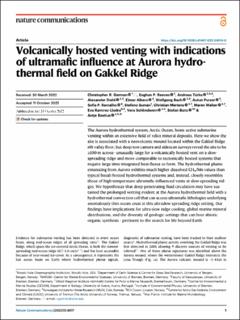| dc.contributor.author | German, Christopher R. | |
| dc.contributor.author | Reeves, Eoghan | |
| dc.contributor.author | Türke, Andreas | |
| dc.contributor.author | Diehl, Alexander | |
| dc.contributor.author | Albers, Elmar | |
| dc.contributor.author | Bach, Wolfgang | |
| dc.contributor.author | Purser, Autun | |
| dc.contributor.author | Ramalho, Sofia P. | |
| dc.contributor.author | Suman, Stefano | |
| dc.contributor.author | Mertens, Christian | |
| dc.contributor.author | Walter, Maren | |
| dc.contributor.author | Ramirez-Llodra, Eva | |
| dc.contributor.author | Schlindwein, Vera | |
| dc.contributor.author | Bünz, Stefan | |
| dc.contributor.author | Boetius, Antje | |
| dc.date.accessioned | 2022-11-07T12:34:45Z | |
| dc.date.available | 2022-11-07T12:34:45Z | |
| dc.date.created | 2022-11-02T15:50:39Z | |
| dc.date.issued | 2022 | |
| dc.identifier.issn | 2041-1723 | |
| dc.identifier.uri | https://hdl.handle.net/11250/3030429 | |
| dc.description.abstract | The Aurora hydrothermal system, Arctic Ocean, hosts active submarine venting within an extensive field of relict mineral deposits. Here we show the site is associated with a neovolcanic mound located within the Gakkel Ridge rift-valley floor, but deep-tow camera and sidescan surveys reveal the site to be ≥100 m across—unusually large for a volcanically hosted vent on a slow-spreading ridge and more comparable to tectonically hosted systems that require large time-integrated heat-fluxes to form. The hydrothermal plume emanating from Aurora exhibits much higher dissolved CH4/Mn values than typical basalt-hosted hydrothermal systems and, instead, closely resembles those of high-temperature ultramafic-influenced vents at slow-spreading ridges. We hypothesize that deep-penetrating fluid circulation may have sustained the prolonged venting evident at the Aurora hydrothermal field with a hydrothermal convection cell that can access ultramafic lithologies underlying anomalously thin ocean crust at this ultraslow spreading ridge setting. Our findings have implications for ultra-slow ridge cooling, global marine mineral distributions, and the diversity of geologic settings that can host abiotic organic synthesis - pertinent to the search for life beyond Earth | en_US |
| dc.language.iso | eng | en_US |
| dc.publisher | Nature | en_US |
| dc.rights | Navngivelse 4.0 Internasjonal | * |
| dc.rights.uri | http://creativecommons.org/licenses/by/4.0/deed.no | * |
| dc.title | Volcanically hosted venting with indications of ultramafic influence at Aurora hydrothermal field on Gakkel Ridge | en_US |
| dc.type | Journal article | en_US |
| dc.type | Peer reviewed | en_US |
| dc.description.version | publishedVersion | en_US |
| dc.rights.holder | Copyright 2022 The Author(s) | en_US |
| dc.source.articlenumber | 6517 | en_US |
| cristin.ispublished | true | |
| cristin.fulltext | original | |
| cristin.qualitycode | 2 | |
| dc.identifier.doi | 10.1038/s41467-022-34014-0 | |
| dc.identifier.cristin | 2068223 | |
| dc.source.journal | Nature Communications | en_US |
| dc.relation.project | NASA National Aeronautics and Space Administration: NNX16AL04G | en_US |
| dc.relation.project | ERC-European Research Council: 294757 | en_US |
| dc.relation.project | NASA National Aeronautics and Space Administration: NSSC19K1427 | en_US |
| dc.relation.project | Norges forskningsråd: 223259 | en_US |
| dc.relation.project | Norges forskningsråd: 274330 | en_US |
| dc.identifier.citation | Nature Communications. 2022, 13, 6517. | en_US |
| dc.source.volume | 13 | en_US |

